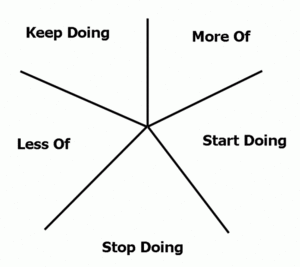Starfish

The Starfish can be used wherever you want to get an overview over how people perceive the status quo. It can be used as a gather data exercise in retrospectives or as feedback tool after events.
Goal
gather data on current practices
Materials
Instructions
The Retrospective Starfish
Diagrams are always useful focal points for starting discussions, and that’s one reason I like using the starfish diagram for a retrospective. This particular retrospective technique helps people by getting them to reflect on varying degrees of things that they want to bring up, without having it fit into the black or white category of ‘What Went Well’ or ‘Not So Well’ so I think it scales a little bit better.
A little bit about each category:
Keep Doing – Is a good starting point for team members to focus on typically all the good things that they liked about a project. You might want to encourage people to think about things in terms of, what would they miss if they didn’t have a particular practice, technique, technology, person, role, etc. A good example from a real session I’ve been in before is ‘Running performance benchmarking and tuning during an iteration helps to identify regressions or slowdowns so we can address them earlier’.
Less Of – Helps to focus on practices that might need a bit more refining or that were simply not helpful in the current circumstance. Perhaps they add value but not as much as other practices could. An example here is that perhaps stand ups have become status meetings and so there should less of talking to one person (and more of talking to each other) during them.
More Of – Is another type of focus that helps further refine or highlight practices, technologies, etc that team members might want to try more and are not necessarily taking full advantage of. A good example is that maybe people are pair programming but knowledge transfer and a better understanding of the code changing might be gained by doing more of swapping programming partners.
Stop Doing – Obviously for things that are not very helpful to development practices or not adding much value. Perhaps it’s about writing that status reporting email at the end of the day (because you can substitute a simple one minute conversation for it instead)
Start Doing – Is a great opportunity for team members to suggest new things to try because of things that may not have gone so well or just for simply keeping things dynamic and fun. Perhaps you might want to try a burn up chart on the whiteboard or try some new open source tool for helping improve developer productivity.
Interpreting the Starfish
Getting people to either write things up under the starfish in this manner gives you a scattergram of sorts and is a great visual technique of estimating the overall health of your project. Most of the points on the starfish also try to coerce people into actually creating action items instead of simply saying that something was not good.
Attachments
- StarTechnique.gif